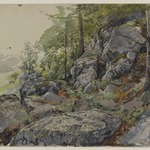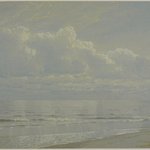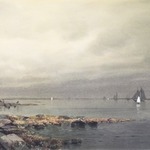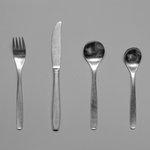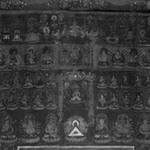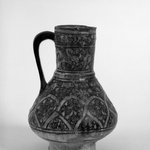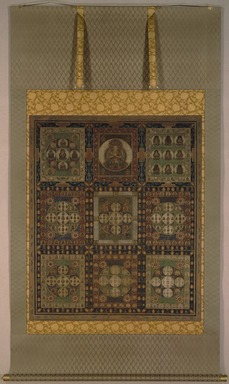

Kongō-kai Mandara, 14th century. Opaque watercolor, ink and gold on silk, overall: 84 × 47 3/8 in. (213.4 × 120.3 cm). Brooklyn Museum, Museum Collection Fund, 21.240.1 (Photo: Brooklyn Museum, 21.240.1_edited_SL1.jpg)

Kongō-kai Mandara, 14th century. Opaque watercolor, ink and gold on silk, overall: 84 × 47 3/8 in. (213.4 × 120.3 cm). Brooklyn Museum, Museum Collection Fund, 21.240.1 (Photo: Brooklyn Museum, 21.240.1_bw_IMLS.jpg)
Kongō-kai Mandara
Asian Art
The mandala (or mandara in Japanese) is a diagrammatic tool used by Buddhists to guide their meditation and prayer. Most mandalas direct the viewer to travel mentally on a prescribed path, stopping to contemplate and address each figure depicted. In this early Diamond World (Kongō-kai) mandala, the primary deity, Dainichi Buddha, is in the top section; in most other mandalas the primary deity appears at the center. The mate to this painting is displayed in the Arts of Japan gallery, on this floor.
MEDIUM
Opaque watercolor, ink and gold on silk
DATES
14th century
PERIOD
Nanbokucho Period
DIMENSIONS
overall: 84 × 47 3/8 in. (213.4 × 120.3 cm)
image: 46 9/16 × 38 13/16 in. (118.3 × 98.6 cm) (show scale)



COLLECTIONS
Asian Art
ACCESSION NUMBER
21.240.1
CREDIT LINE
Museum Collection Fund
CATALOGUE DESCRIPTION
Description with 21.240.2:
Two large, rectangular cosmic diagrams, painted in colors and gold on silk, which together form the Ryokai Mandara. Such pictures that depict Buddhist deities arranged in a geometrical pattern are the principal objects displayed in the temples of the Shingon sect, although these objects are more likely form the Tendai Sect. The teachings of Tendai and Shingon were practiced simultaneously at several Buddhist temples in Japan. These scrolls are typical products of esoteric Buddhism, the meaning of whose complex teaching could be explained more easily in pictures then in words. They are displayed during the ceremony of Kancho (baptism). According to Professors Shunsho Manabe and Ryuichi Abe (Dec 16, 2002) they also were originally displayed in the Adhisekhara ritual initiation and the month of January for the New Years festival.
21.240.1
No. 1 is the Kongokai (Vajradhutu Mandara). It is also called the Nishi or Western Mandara. It consists of six squares framed by borders containing Buddhist deities or symbols. In the upper center square is Dainichi Nyorai (Vairocana) seated on a lotus pedestal within a circle, and with two halos behind him. In the four corners of the square are Buddhist vessels. In the square to his proper left are nine Buddhist deities arranged in rows of three each against a green ground cross hatched with gold. All of the other squares contain smaller figures of deities, or their symbols, arranged five within a circle, and five of these circles within a larger circle, this latter circle set on a green ground lined with gold within a square. Lotus flowers are generally in the corners of the squares. The deities and their symbols arranged in this geometrical fashion are regarded as emanations of Dainichi Nyorai. A narrow border of stylized blue leaves on a pink ground surrounds the picture.
According to Shunsho Manabe, there is no similar example.
21.240.2
No. 2 is the Taizokai or Garbhadhatu Mandara, and is also known as the Higashi or Eastern Mandara. In the center is Dainichi Nyorai (Vairocana) seated on a lotus pedestal within a circle, and with two circles behind him. From this circle emanates the eight lobed Mahavairocana lotus. The petals are divided by vajra, each petal containing one of the four Dhyani Buddhas or his Bodhisattva. This group is contained in a square with green ground lined with gold. Above the square is a triangle topped by a leaf-shaped device (both the triangle and leaf contain a swastika) backed by a halo and resting on a lotus base. Two swastikas presented in this way are rare and hint at the connection with the Tendai sect (the Shingon sect typically only illustrates one). It is the symbol of Adi-Dharma or matter. The central square is surrounded by three rows of Buddhist divinities on a dark blue ground, one row on a green ground, and an outer row of smaller figures again on a dark blue ground, all arranged in hieratic fashion. They are regarded as emanations of Dainichi Nyorai. According to Shunsho Manabe, in the outer boarder is represented the Juniten (12 deva guardians who are the gods of the 12 directions) who are transmigrating through the six paths. The bottom of the outer boarder represents the pure land (amitabha) A narrow border of flowers on a red ground surrounds the picture. This mandara represents the world forms and its dynamic activity, while the other mandara represents the static world of ideas.
According to Shunsho Manabe, there is a similar piece in the Barnet Burto collection, Cambridge. Also, Hyogo Prefecture has a mandara almost identical, which is dated to the Kamakura period.
Both 21.240.1-2
Each picture has two borders, each narrow on the sides but wide above and below. The first is of light yellowish brown compound satin weave silk, patterned with all-over lotus scrolls made by the extra flat guild paper weft threads. The second and far larger paintings, of similarly woven blue silk, is so patterned by the flat guild paper extra weft threads that the allover design of diagonal cloud bands, stylized flower medallions, swastikas and other patterns appear in blue on a gold ground. The colors of the paintings are now subdued. The silk is cracked and torn and much of the paint is chipped. The execution, however, is excellent, and the silk is of a close fine weave. (This also may have changed since because of the conservation work).
MUSEUM LOCATION
This item is not on view
CAPTION
Kongō-kai Mandara, 14th century. Opaque watercolor, ink and gold on silk, overall: 84 × 47 3/8 in. (213.4 × 120.3 cm). Brooklyn Museum, Museum Collection Fund, 21.240.1 (Photo: Brooklyn Museum, 21.240.1_edited_SL1.jpg)
IMAGE
overall, 21.240.1_edited_SL1.jpg. Brooklyn Museum photograph
"CUR" at the beginning of an image file name means that the image was created by a curatorial staff member. These study images may be digital point-and-shoot photographs, when we don\'t yet have high-quality studio photography, or they may be scans of older negatives, slides, or photographic prints, providing historical documentation of the object.
RIGHTS STATEMENT
No known copyright restrictions
This work may be in the public domain in the United States. Works created by United States and non-United States nationals published prior to 1923 are in the public domain, subject to the terms of any applicable treaty or agreement.
You may download and use Brooklyn Museum images of this work. Please include caption information from this page and credit the Brooklyn Museum. If you need a high resolution file, please fill out our online application form (charges apply).
The Museum does not warrant that the use of this work will not infringe on the rights of third parties, such as artists or artists' heirs holding the rights to the work. It is your responsibility to determine and satisfy copyright or other use restrictions before copying, transmitting, or making other use of protected items beyond that allowed by "fair use," as such term is understood under the United States Copyright Act.
The Brooklyn Museum makes no representations or warranties with respect to the application or terms of any international agreement governing copyright protection in the United States for works created by foreign nationals.
For further information about copyright, we recommend resources at the United States Library of Congress, Cornell University, Copyright and Cultural Institutions: Guidelines for U.S. Libraries, Archives, and Museums, and Copyright Watch.
For more information about the Museum's rights project, including how rights types are assigned, please see our blog posts on copyright.
If you have any information regarding this work and rights to it, please contact copyright@brooklynmuseum.org.
RECORD COMPLETENESS
Not every record you will find here is complete. More information is available for some works than for others, and some entries have been updated more recently. Records are frequently reviewed and revised, and we welcome any additional information you might have.










